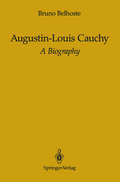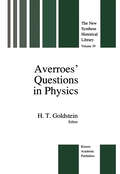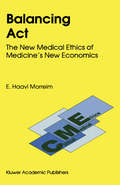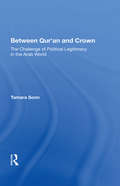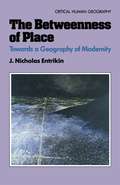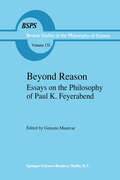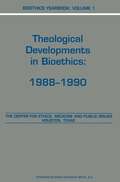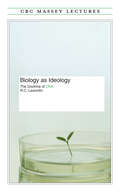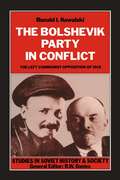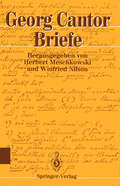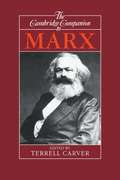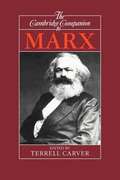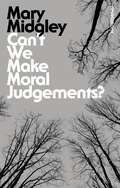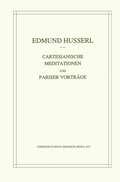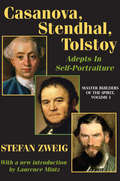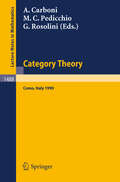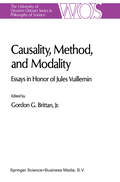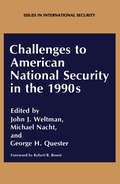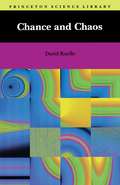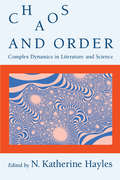- Table View
- List View
Ästhetik des Nihilismus: Von der Romantik zum Modernismus
by Bruno HillebrandVon Nietzsche bis Heidegger. Der Nihilismus als Geistesphänomen und Erlebnis zeigt sich zum ersten Mal in der deutschen Romantik. Er stand im Zentrum von Philosophie und Literatur im 19. Jahrhundert. Im 20. Jahrhundert hat sich der Nihilismus als Kulturphänomen - im Bereich aller Künste - fest etabliert. Mit Blick auf die Herkunft, vor allem auf Nietzsche, beschreibt Bruno Hillebrand die Geschichte der Ästhetik des Nihilismus.
Augustin-Louis Cauchy: A Biography
by Bruno BelhosteA great difficulty facing a biographer of Cauchy is that of delineating the curious interplay between the man, his times, and his scientific endeavors. Professor Belhoste has succeeded admirably in meeting this challenge and has thus written a vivid biography that is both readable and informative. His subject stands out as one of the most brilliant, versatile, and prolific fig ures in the annals of science. Nearly two hundred years have now passed since the young Cauchy set about his task of clarifying mathematics, extending it, applying it wherever possible, and placing it on a firm theoretical footing. Through Belhoste's work we are afforded a detailed, rather personalized picture of how a first rate mathematician worked at his discipline - his strivings, his inspirations, his triumphs, his failures, and above all, his conflicts and his errors.
Averroes’ Questions in Physics (The New Synthese Historical Library #39)
by Helen TunikGoldsteinoverall title and the commentary of Narboni, but in which the treatise is given a close association rath De Substantia Orbis VII, which immedi ately follows it in the text. This third version is the sole case in which a Hebrew translator can be named: the translation was made by Todros Todrosi in the year 1340. The only conclusion to be drawn from his translation is that Todrosi may definitively be eliminated as the translator of any of the other ver sions. However, we may be able to draw a tentative conclusion as to the formation of the Hebrew collection. The earliest evidence for the existence of the nine treatise collec tion is the commentary of Narboni, completed in 1349. The fact that nine years earlier one treatise could be attached to a work outside the corpus may indicate that the Hebrew collection of nine treatises was formed during those nine years, or mar even indicate that Narboni him self collected the various treatises. 5 Narboni, however, was not the translator of these works In fact, no 1 definitive indication of the translator's identity exists. 6 3. The Nature of the Question-Form Steinschneider offered the following general characterization of Aver roes' Quaestiones: These are mostly brief discussions, more or less answers to questions; they may be partially occasioned by topics i9 his commentaries and may be considered as appendices to them.
Balancing Act: The New Medical Ethics of Medicine’s New Economics (Clinical Medical Ethics #3)
by E. Haavi MorreimMedicine's changing economics have already fundamentally, permanently altered the relationship between physician and patient, E. Haavi Morreim argues. Physicians must weigh a patient's interests against the legitimate, competing claims of other patients, of payers, of society as a whole, and sometimes even of the physician himself. Focusing on actual situations in the clinical setting, Morreim explores the complex moral problems that current economic realities pose for the practicing physician. She redefines the moral obligations of both physicians and patients, traces the specific effects of these redefined obligations on clinical practice, and explores the implications for patients as individuals and for national health policy. Although the book focuses on health care in the United States, physicians everywhere are likely to face many of the same basic issues of clinical ethics, because every system of health care financing and distribution today is constrained by finite resources.
Between Qur'an And Crown: The Challenge Of Political Legitimacy In The Arab World
by Tamara SonnThe struggle for political legitimacy in many Middle Eastern countries today poses a dilemma for ruling elites. In order to maintain authority, leaders often must capitulate to Islamic universalist dogma, which may conflict with their own views of the state as well as threaten the legitimacy of other leaders in the region who are attempting to establish a secular, national basis for government. Tracing the roots of this dilemma in Middle Eastern history and Islamic philosophy, Dr. Sonn compares the contemporary Middle Eastern period to Europe’s “Age of Religious Wars†that preceded the emergence of the Western secular state. She describes how a process similar to the organic development of the secular state in Europe was interrupted in the Middle East by oppressive Western colonialism, which eventually led to the Muslim rejection of nationalism and all things “Western†and to the reassertion of Islam as the sole source of political legitimacy. The author shows how the philosophy of Islamic traditionalism opposes the two fundamentals of stable national political systems—a geographical limitation of authority and an institutionalized process for regular changes in leadership. Dr. Sonn bases her argument on an insightful examination of Middle Eastern history, from the formation and disintegration of the Ottoman Empire in the late nineteenth century to the present, and caps it with a detailed look at a possible solution to the dilemma: the teachings of modern scholars who advocate a new “Islamic realism†incorporating a limited definition of national identity and interests while retaining Islamic social goals.
Between Qur'an And Crown: The Challenge Of Political Legitimacy In The Arab World
by Tamara SonnThe struggle for political legitimacy in many Middle Eastern countries today poses a dilemma for ruling elites. In order to maintain authority, leaders often must capitulate to Islamic universalist dogma, which may conflict with their own views of the state as well as threaten the legitimacy of other leaders in the region who are attempting to establish a secular, national basis for government. Tracing the roots of this dilemma in Middle Eastern history and Islamic philosophy, Dr. Sonn compares the contemporary Middle Eastern period to Europe’s “Age of Religious Wars†that preceded the emergence of the Western secular state. She describes how a process similar to the organic development of the secular state in Europe was interrupted in the Middle East by oppressive Western colonialism, which eventually led to the Muslim rejection of nationalism and all things “Western†and to the reassertion of Islam as the sole source of political legitimacy. The author shows how the philosophy of Islamic traditionalism opposes the two fundamentals of stable national political systems—a geographical limitation of authority and an institutionalized process for regular changes in leadership. Dr. Sonn bases her argument on an insightful examination of Middle Eastern history, from the formation and disintegration of the Ottoman Empire in the late nineteenth century to the present, and caps it with a detailed look at a possible solution to the dilemma: the teachings of modern scholars who advocate a new “Islamic realism†incorporating a limited definition of national identity and interests while retaining Islamic social goals.
The Betweenness of Place: Towards a Geography of Modernity (Critical Human Geography)
by J. Nicholas EntrikinIn this original and important new book, Professor Entrikin argues that there is no essence or universal structure of place waiting to be uncovered or discovered by the theorist. The significance of place is associated with our 'situatedness' as human agents and is always best understood from a point of view and best represented in terms of narrative which can appreciate its specificity without reducing its richness as context to its more limited sense as location.
Beyond Reason: Essays on the Philosophy of Paul Feyerabend (Boston Studies in the Philosophy and History of Science #132)
by Gonzalo MunévarSome philosophers think that Paul Feyerabend is a clown, a great many others think that he is one of the most exciting philosophers of science of this century. For me the truth does not lie somewhere in between, for I am decidedly of the second opinion, an opinion that is becoming general around the world as this century comes to an end and history begins to cast its appraising eye upon the intellectual harvest of our era. A good example of this opinion may be found in the admiration for Feyerabend's philosophy of science expressed by Grover Maxwell in his contribution to this volume. Maxwell, recalling his own intellectual transformation, says also that it was Feyerabend who "confirmed my then incipient suspicions that most of the foundations of currently fashionable philosophy and even a great deal of the methodology to which many scientists pay enthusiastic lip service are based on simple mistake- assumptions whose absurdity becomes obvious once attention is directed at them". And lest the reader thinks, as many still do, that however sharp Feyerabend's attacks upon the philosophical establishment may have been, he does not offer a positive philosophy (a complain made by C.A. Hooker and some of the other contributors), Paul Churchland argues otherwise.
Bioethics Yearbook: Theological Developments in Bioethics: 1988–1990 (Bioethics Yearbook #1)
by Thomas J. Bole Laurence B. McCullough H. TristramEngelhardt B. AndrewLustig Baruch A. BrodyAs the field of bioethics has matured, increasing attention is being paid to how bioethical issues are treated in different moral and religious traditions and in different parts of the world. It is often difficult, however, to get accurate information about these matters. The Bioethics Yearbook Series provides interested parties with analyses of how such issues as new reproductive techniques, abortion, maternal-fetal conflicts, care of seriously ill newborns, consent, confidentiality, equitable access, cost-containment, withdrawing treatment, active euthanasia, the definition of death, and organ transplantation are being discussed in these different traditions and different parts of the world. The first volume, and every second succeeding volume, will discuss developments in the Anglican, Baptist, Buddhist, Catholic, Eastern Orthodox, Hindu, Jewish, LDS, Lutheran, Methodist, Muslim, and Presbyterian Traditions. The second volume, and every second volume succeeding it, will discuss official governmental and medical society policies on these topics throughout the world.
Biology As Ideology: The Doctrine of DNA (The CBC Massey Lectures)
by Richard LewontinR. C. Lewontin is a prominent scientist -- a geneticist who teaches at Harvard -- yet he believes that we have placed science on a pedestal, treating it as an objective body of knowledge that transcends all other ways of knowing and all other endeavours.Lewontin writes in this collection of essays, which began their life as CBC Radio's Massey Lectures Series for 1990: "Scientists do not begin life as scientists, after all, but as social beings immersed in a family, a state, a productive structure, and they view nature through a lens that has been molded by their social experience… . Science, like the Church before it, is a supremely social institution, reflecting and reinforcing the dominant values and vices of society at each historical epoch."In Biology as Ideology Lewontin examines the false paths down which modern scientific ideology has led us. By admitting science's limitations, he helps us rediscover the richness of nature -- and appreciate the real value of science.
Bolshevik Party in Conflict: The Left Communist Opposition of 1918 (Studies in Soviet History and Society)
by Ronald I. KowalskiAn examination of the part played by the left Communists following the Russian revolution, the largest opposition to state socialism until the 1990s. The author feels that the leftist's vision offered no viable model for the construction of a democratic socialist society.
Briefe
by Georg CantorDas Buch enthält 185 vollständige chronologisch geordnete Briefe Cantors aus den verschiedenen Perioden seines Lebens, von denen ein großer Teil erstmals veröffentlicht wird. Aus ihnen wird die Entwicklung des Cantorschen Werkes ebenso deutlich wie die Stellung zu seinen Kollegen und das Ringen um die Anerkennung seiner Theorie. Durch die Vollständigkeit der Briefe und die damit verbundene Einbeziehung auch privater Passagen gewinnt man darüber hinaus Einblicke in Bereiche dieses Forscherlebens, ohne die man die vielschichtige Persönlichkeit Cantors kaum annähernd erfassen kann. Man erkennt, daß manches an dem bisherigen "Cantorbild" revisionsbedürftig ist oder zumindest differenzierter gesehen werden muß. Die den Briefen beigegebenen ergänzenden und erläuternden Kommentare enthalten häufig Passagen aus Antwortschreiben oder weiteren Briefen Cantors, die für das Verständnis der behandelten Sachverhalte hilfreich sind oder sogar neue Aspekte erkennen lassen. Ferner weisen sie auf Zusammenhänge zwischen den Briefen hin. Eine so ausgiebige Kommentierung ist bei wissenschaftlichen Briefsammlungen nicht sehr verbreitet. Ebenfalls hervorzuheben ist das sorgfältig zusammengestellte Sachverzeichnis, das zugleich Hinweise auf die in den Briefen behandelten Themen gibt. Man gewinnt mit diesem Werk eine "Autobiographie" Cantors, die zusammen mit den von Zermelo herausgegebenen "Gesammelten Abhandlungen" (auf die häufig verwiesen wird) ein umfassendes Bild von Leben und Werk dieses großen Forschers liefert.
The Cambridge Companion To Marx (PDF)
by Terrell CarverMarx was a highly original and polymathic thinker, unhampered by disciplinary boundaries, whose intellectual influence has been enormous. Yet in the wake of the collapse of Marxism-Leninism in Eastern Europe the question arises as to how important his work really is for us now. An important dimension of this volume is to place Marx's writings in their historical context and to separate what he actually said from what others (in particular, Engels) interpreted him as saying. Informed by current debates and new perspectives, the volume provides a comprehensive coverage of all the major areas to which Marx made significant contributions.
The Cambridge Companion To Marx (PDF)
by Terrell CarverMarx was a highly original and polymathic thinker, unhampered by disciplinary boundaries, whose intellectual influence has been enormous. Yet in the wake of the collapse of Marxism-Leninism in Eastern Europe the question arises as to how important his work really is for us now. An important dimension of this volume is to place Marx's writings in their historical context and to separate what he actually said from what others (in particular, Engels) interpreted him as saying. Informed by current debates and new perspectives, the volume provides a comprehensive coverage of all the major areas to which Marx made significant contributions.
The Cambridge Companion To Marx (PDF)
by Terrell CarverMarx was a highly original and polymathic thinker, unhampered by disciplinary boundaries, whose intellectual influence has been enormous. Yet in the wake of the collapse of Marxism-Leninism in Eastern Europe the question arises as to how important his work really is for us now. An important dimension of this volume is to place Marx's writings in their historical context and to separate what he actually said from what others (in particular, Engels) interpreted him as saying. Informed by current debates and new perspectives, the volume provides a comprehensive coverage of all the major areas to which Marx made significant contributions.
Can't We Make Moral Judgements? (Bloomsbury Revelations)
by Mary MidgleyHow many times do we hear the statement 'It's not for me to judge'? It conveys one of the most popular ideas of our time: that to make judgements of others is essentially wrong. In this classic text, the renowned moral philosopher Mary Midgely turns a spotlight on the ever popular stance in society that we should not make moral judgements on others. Guiding the reader through the diverse approaches to this complex subject, she interrogates our strong beliefs about such things as the value of freedom that underlie our scepticism about making moral judgements. She shows how the question of whether or not we can make these judgements must inevitably affect our attitudes not only to the law and its institutions but also to events that occur in our daily lives, and suggests that mistrust of moral judgements may be making life even harder for us than it would be otherwise. The texts and philosophers discussed range from Nietzsche and Sartre to P.D. James and the Bhagavad Gita. The Bloomsbury Revelations edition includes a new preface from the author.
Cartesianische Meditationen und Pariser Vortrage (Husserliana: Edmund Husserl – Gesammelte Werke #1)
by Edmund Husserl Stephan StrasserCasanova, Stendhal, Tolstoy: Volume 3, Master Builders of the Spirit
by Jay KatzCasanova, Stendhal, Tolstoy: Adepts in Self-Portraiture, the final volume of Stefan Zweig's masterful Master Builders of the Spirit trilogy, discloses the smaller version of a writer's own ego. Unconscious though it is, no reality is as important to the writer as the reality of their own life. Giacomo Casanova, Stendhal (Marie-Henri Beyle), and Leo Tolstoy have different approaches to self-portraiture, but Zweig shows that together they symbolize three levels which represent successively ascending gradations of the same creative function.Casanova is depicted as having a primitive gradation; he simply records deeds and happenings, without any attempt to appraise them or to study the deeper working of the self. Stendhal's self-portraiture is depicted as psychological; he observes himself and investigates his own feelings. Tolstoy has the highest level; he describes his own life, records what led him to his own actions, and focuses on self-reflection in a completely unexaggerated manner.At first glance it might seem as if self-portraiture is an artist's easiest task. With no further trouble than a probing of memory and a description of the facts of life, "the truth" is revealed. The history of literature shows that ordinary autobiographers are no more than commonplace witnesses testifying to facts that chance has brought to their knowledge. A practiced artist is needed to discern the innermost happenings of the soul; few who have attempted autobiography have been successful in this difficult task. The present volume expounds the characteristics of these subjectively minded artists, and of autobiography as their typical method of personal expression.
Casanova, Stendhal, Tolstoy: Volume 3, Master Builders of the Spirit
by Jay KatzCasanova, Stendhal, Tolstoy: Adepts in Self-Portraiture, the final volume of Stefan Zweig's masterful Master Builders of the Spirit trilogy, discloses the smaller version of a writer's own ego. Unconscious though it is, no reality is as important to the writer as the reality of their own life. Giacomo Casanova, Stendhal (Marie-Henri Beyle), and Leo Tolstoy have different approaches to self-portraiture, but Zweig shows that together they symbolize three levels which represent successively ascending gradations of the same creative function.Casanova is depicted as having a primitive gradation; he simply records deeds and happenings, without any attempt to appraise them or to study the deeper working of the self. Stendhal's self-portraiture is depicted as psychological; he observes himself and investigates his own feelings. Tolstoy has the highest level; he describes his own life, records what led him to his own actions, and focuses on self-reflection in a completely unexaggerated manner.At first glance it might seem as if self-portraiture is an artist's easiest task. With no further trouble than a probing of memory and a description of the facts of life, "the truth" is revealed. The history of literature shows that ordinary autobiographers are no more than commonplace witnesses testifying to facts that chance has brought to their knowledge. A practiced artist is needed to discern the innermost happenings of the soul; few who have attempted autobiography have been successful in this difficult task. The present volume expounds the characteristics of these subjectively minded artists, and of autobiography as their typical method of personal expression.
Category Theory: Proceedings of the International Conference held in Como, Italy, July 22-28, 1990 (Lecture Notes in Mathematics #1488)
by Aurelio Carboni Maria C. Pedicchio Giuseppe RosoliniWith one exception, these papers are original and fully refereed research articles on various applications of Category Theory to Algebraic Topology, Logic and Computer Science. The exception is an outstanding and lengthy survey paper by Joyal/Street (80 pp) on a growing subject: it gives an account of classical Tannaka duality in such a way as to be accessible to the general mathematical reader, and to provide a key for entry to more recent developments and quantum groups. No expertise in either representation theory or category theory is assumed. Topics such as the Fourier cotransform, Tannaka duality for homogeneous spaces, braided tensor categories, Yang-Baxter operators, Knot invariants and quantum groups are introduced and studies. From the Contents: P.J. Freyd: Algebraically complete categories.- J.M.E. Hyland: First steps in synthetic domain theory.- G. Janelidze, W. Tholen: How algebraic is the change-of-base functor?.- A. Joyal, R. Street: An introduction to Tannaka duality and quantum groups.- A. Joyal, M. Tierney: Strong stacks andclassifying spaces.- A. Kock: Algebras for the partial map classifier monad.- F.W. Lawvere: Intrinsic co-Heyting boundaries and the Leibniz rule in certain toposes.- S.H. Schanuel: Negative sets have Euler characteristic and dimension.-
Causality, Method, and Modality: Essays in Honor of Jules Vuillemin (The Western Ontario Series in Philosophy of Science #48)
by Gordon G. BrittanDeservedly so, Jules Vuillemin is widely respected and greatly admired. It is not simply that he has produced a large body of outstanding work, in many different areas of philosophy. Or that he combines to an unusual degree rigorous standards with a very wide perspective. Or even that in his path-breaking accounts of algebra, of !)escartes, of Kant and of Russell, he showed in new and profound ways how the histories of science and philosophy could be used to illuminate each other. It is also that he has pursued the application of formal techniques and the defense of liberal institutions with a rare singlemindedness and courage. In a time and place where the former were generally ignored and the latter often attacked, he carried on, at some personal cost, embodying a traditional and ideal conception of the philosophical life, bridging national differences. Those who know him also treasure his friendship. Always curious, he delights in new facts and new experiences, and continually heightens the perception of those around him. Almost yearly, at the College de France he introduced brand new courses always with fresh and fruitful inSights. Exceptionally solicitous, he follows the lives of the families around him in great detail. The devotion of his students is legend. His personal energy is also legend. Many of us have followed him bounding up the stairs two at a time or through the gardens of the Luxembourg, his wit and irony apace.
Challenges to American National Security in the 1990s (Issues in International Security)
by M. Nacht A. Nichols G. H. Quester J. J. WeltmanThe decade of the 1990s offers a chance to build a new and better international order. What policy choices will this decade pose for the United States? This wide-ranging volume of essays imaginatively addresses these crucial issues. The peaceful revolutions of 1989-1990 in the Soviet Union and Eastern Europe have swept away the foundations of the Cold War. The Eastern European nations are free; Europe is no longer divided; Germany is united. The Soviet threat to Western Europe is ending with the collapse of the Warsaw Pact and the withdrawals and asymmetrical cuts of Soviet forces. And U.S.-Soviet rivalry in the Third World is giving way to cooperation in handling conflicts, as in Iraq and elsewhere. Much, of course, remains uncertain and unsettled. What sort of Soviet Union will emerge from the ongoing turmoil, with what political and economic system and what state structure? How far and how soon will the Eastern Euro pean states succeed in developing pluralist democracies and market economies? Are the changes irreversible? Certainly there will be turmoil, backsliding, and failures, but a return to the Cold War hardly seems likely.
Chance and Chaos (Princeton Science Library #110)
by David RuelleHow do scientists look at chance, or randomness, and chaos in physical systems? In answering this question for a general audience, Ruelle writes in the best French tradition: he has produced an authoritative and elegant book--a model of clarity, succinctness, and a humor bordering at times on the sardonic.
Change, Cause and Contradiction: A Defence of the Tenseless Theory of Time (Studies In Contemporary Philosophy Ser.)
by Robin LeChaos and Order: Complex Dynamics in Literature and Science (New Practices of Inquiry)
by N. Katherine HaylesThe scientific discovery that chaotic systems embody deep structures of order is one of such wide-ranging implications that it has attracted attention across a spectrum of disciplines, including the humanities. In this volume, fourteen theorists explore the significance for literary and cultural studies of the new paradigm of chaotics, forging connections between contemporary literature and the science of chaos. They examine how changing ideas of order and disorder enable new readings of scientific and literary texts, from Newton's Principia to Ruskin's autobiography, from Victorian serial fiction to Borges's short stories. N. Katherine Hayles traces shifts in meaning that chaos has undergone within the Western tradition, suggesting that the science of chaos articulates categories that cannot be assimilated into the traditional dichotomy of order and disorder. She and her contributors take the relation between order and disorder as a theme and develop its implications for understanding texts, metaphors, metafiction, audience response, and the process of interpretation itself. Their innovative and diverse work opens the interdisciplinary field of chaotics to literary inquiry.

